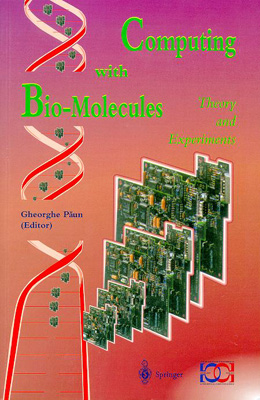

G. Paun (ed.). Computing with Biomolecules. Theory and Experiments, Springer-Verlag, Singapore, 1998, viii + 350 pp. ISBN : 981-4021-05-9. US$59 softcover.
Molecular computing (especially DNA computing) means using bio-molecules as a support for computations and devising computers. This is in contrast to the current opposite direction of research, the classic one, where computers are used in studying molecules (especially DNA), a field now commonly termed the science of Bioinformatics. Using DNA as a "chip" or support for computation is not a new idea, and has been speculated upon since the 1950's. Adleman's 1994 report on solving the Hamiltonian Path Problem in a graph, using only biochemical laboratory techniques, was the revolutionary turning point in making possible the construction of large computers of huge parallelism, which are able to incorporate the features of matching, splicing (cross-over), insertion, deletions, etc., of data structures (strings and languages) - all features typical of the living DNA molecule. DNA computing is a domain of clear interdisciplinary work, and is definitely a field in rising expansion. Still, a lot of work has to be done, both from a mathematical and a biochemical point of view. This book brings together over 20 international contributions on the theoretical and experimental works of scientists in search of the bio-computer. The style of the contributions are that of research papers and surveys. Being one of the first volumes of its type in this new exciting field, this book will be of equal interest to computer scientists, mathematicians, and biochemists alike.
Contents: Introduction; Mechanical Devices; Engineering Creativity; Rational Problem Solving; Creative Techniques; Creative Design Methodology; Generalization; Generalized Chains; Kinematic Chains; Specialization; Clamping Devices; Motorcross Suspension Mechanisms; Infinitely Variable Transmissions; Configurations of Machining Centers; Index.